Intel P-Core Versus E-Core The Great Divide
We covered the P-core versus E-core aspect of Intel Xeon 6 thoroughly in our Intel Xeon 6 6700E Sierra Forest Shatters Xeon Expectations piece. It is important since Intel has a different strategy for its cloud-native CPU line than AMD. Intel is going head-to-head with Arm chips like AmpereOne with its E-cores and at the same time going head-to-head with AMD EPYC Turin with its P-core line. Here is our discussion from the Sierra Forest launch:
The reason this is, by far, the biggest change to Xeon in decades is that it is the first time we will really have two different core architectures in the mainstream sockets. Intel’s observation (albeit it is far from the first to arrive here) is that there is a set of compute that runs 24×7 at near 100% utilization. Those Performance cores, or P-cores, are designed to deliver the maximum performance per thread. If you have per-core licensed software, HPC applications, big, expensive AI servers, and so forth, you want P-core CPUs. The Efficient Cores or E-cores are designed for this huge body of workloads that needs to exist but are better suited to chasing power efficiency for cost savings rather than maximum performance.
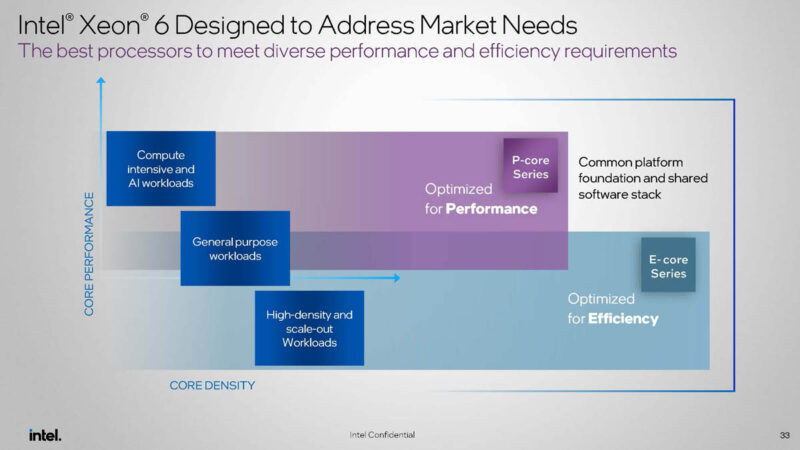
Here is Intel’s shot at which workloads are best suited to P-cores versus E-cores. This is generally pretty good, but virtualization should have a big note on it. A target market for this is cloud CSPs with 2-8 vCPU customer instances that they want to deliver at a lower cost. If your idea of virtualization is VMware or Microsoft Windows Server with core and per socket style licensing, then you would rightly look to P-cores and will miss out on the benefits of E-cores from an efficiency standpoint.
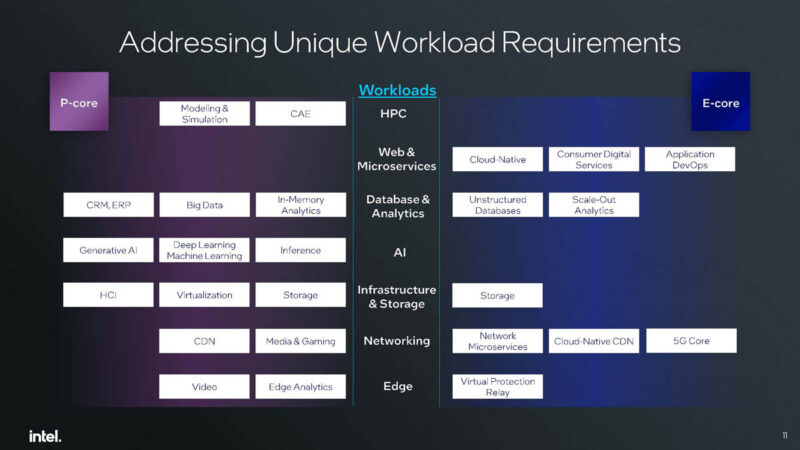
When we say E-core, there are architectural differences. While both have a lot of similar features, AVX-512 and AMX are not present on the E-cores. The P-cores are loaded with acceleration technology.
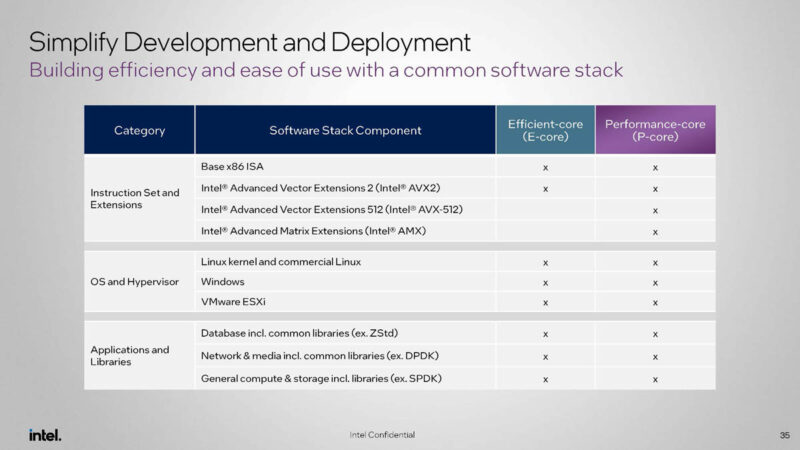
Here is a bit more on the cores. At this point, let us simply look at the codenames. The P-core Redwood Cove is the Meteor Lake generation P-core on the desktop side. The E-core “Crestmont” is the Meteor Lake generation E-core. Of course, that is a bit of an oversimplification, but as Intel launches Lunar Lake, we want to keep folks grounded on where the new chips fall compared to their desktop counterparts.
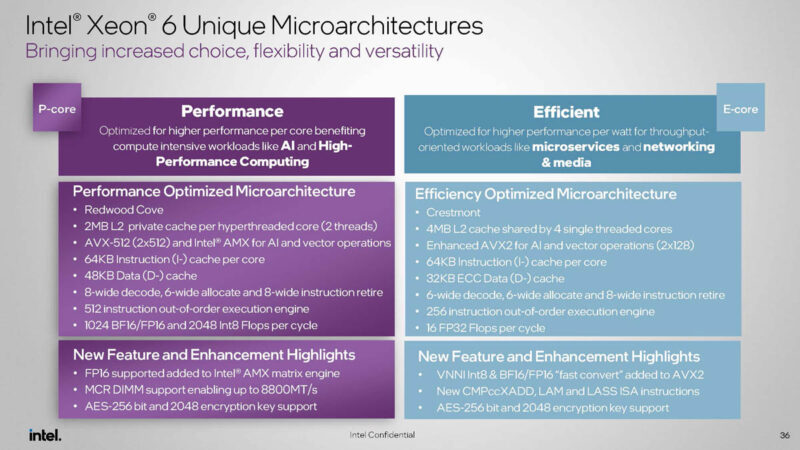
There may be folks that hear E-core and think Atom. That is correct that those are the lineage of the E-core designs. In 2012, for example, we reviewed the all E-core Supermicro X7SPA-HF-D525 with the Atom D525 then the 2013 Intel Atom S1260. 2013 also saw Avoton/ Rangely. In 2017, we reviewed the Atom C3000 series. We have been reviewing the Snow Ridge and Alder Lake-N parts more recently. Still, the theme is that Intel has been increasing the performance per core on its E-cores at an almost absurd rate over the past few years. When we say E-core, instead of thinking about this like it is some super slow core, think of it more like an Intel Xeon E5 V4 core level of performance or a thread of 5th Gen Xeon Emerald Rapids.
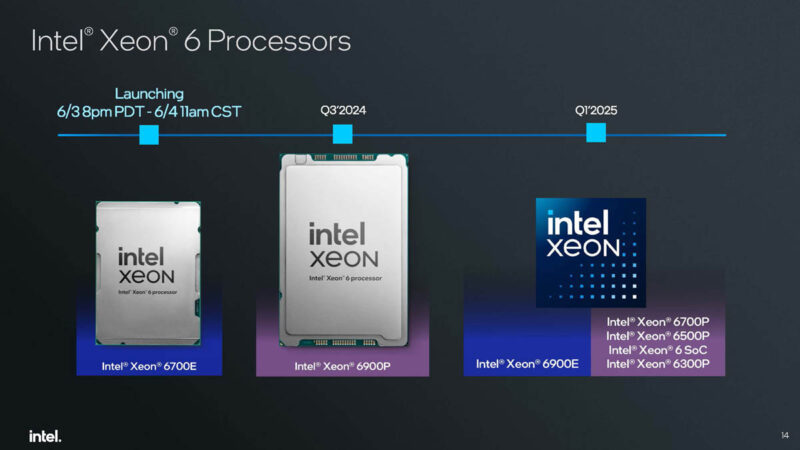
Still, P-cores are far from done. We now get the Intel Xeon 6900P series with up to 128 cores, 12 memory channels, and the ability to use MCR DIMMs/ MRDIMMs. MRDIMMs/ MCRDIMMs will give this new chip bandwidth competitive with the Intel Xeon Max, but without requiring lower capacity HBM onboard. Also important is that the new P-core CPUs have twice the core count of the previous generation.
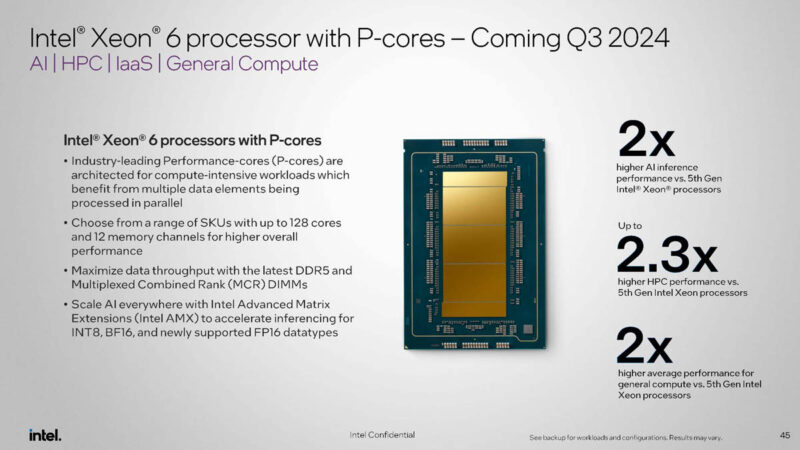
While the Intel Xeon 6900P series is the big socket P-core processor, 2025 will see the big socket Intel Xeon 6900E “Sierra Forest-AP” with up to 288 E-cores.
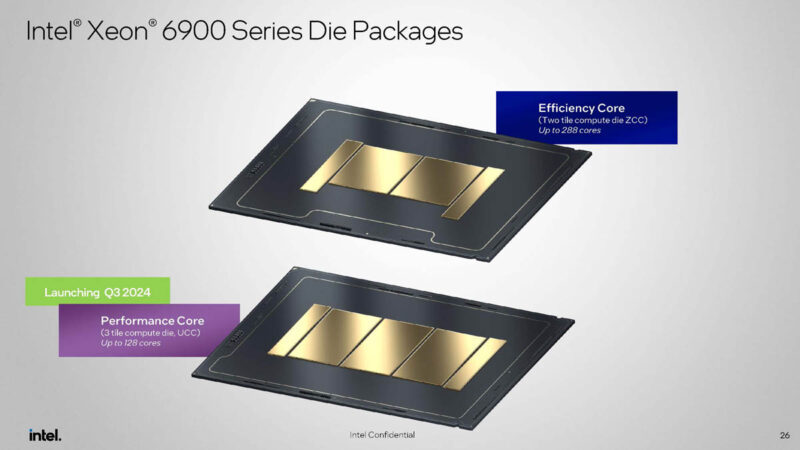
We will get the other models in Q1 2025, like the big socket E-core Sierra Forest-AP with 288 cores per socket and up to 86 P-cores in the smaller socket. There is also a Xeon 6 SoC or Granite Rapids-D on the roadmap for Q1. If this is confusing, here is what we can tell from Intel’s various slides in a single table.

Small socket is LGA4710 and big socket will likely be LGA7529.
If you want to see how much bigger the “big” chips are, here we can see the Xeon 6900 series Granite Rapids-AP, Sierra Forest-AP, and the upcoming Clearwater Forest-AP parts in the back with the Sierra Forest and Granite Rapids Xeon 6700 series in front.
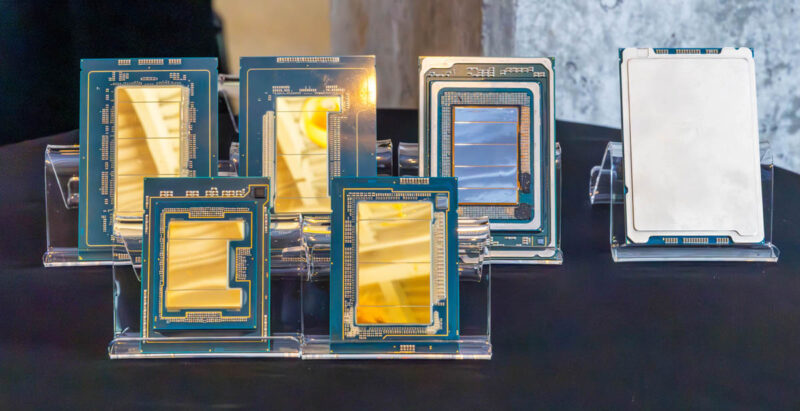
Next, let us get to some of the Intel Xeon 6 platform features.


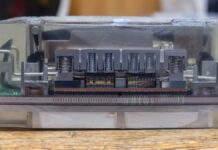
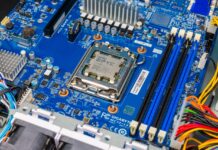
Wow can’t even hide Patrick’s love affair with Intel anymore can we ? Intel has not even properly launched this but yet it’s 128c Intel vs 96c Genoa, but AMD will have same 128c in 2 weeks time……just be honest finally and call it servingintel.com ;-)
Yawn… Still low on PCIe lanes for a server footprint when GPUs and NVME storage is coming fast and furious. Intel needs to be sold so someone can finally innovate.
Whether love or not, the numbers are looking good. For many an important question will be yield rates and pricing.
I wonder why Epyc is missing from the povray speed comparison.
One thing I’d like to see is a 4-core VM running Geekbench 6 while everything else is idle. After that Geekbench for an 8-core VM, 16-core, 32-core and so forth under similar circumstances. This sort of scaling analysis would help determine how well balanced the MCRDIMM memory subsystem is to the high-core-count processors–just the kind of investigative journalism needed right now.
As an asside, I had to work over eight captchas for this post.
The keyword would be availability. I checked just now, and these newer parts don’t have 1k Tray Pricing published yet. So not sure when would they be available. It felt painful to restrict the On-Premise Server procurement specification at 64 cores to get competitive bidding across vendors. Hope for the best.
It is hard not to get excited about competition, Intel has finally done it, they launched something faster than AMDs previous generation… Intel’s focus on AMX accelerations seems to have paid off, I guess we shall see when Turin launches in a few weeks.
@Patrick how do you manage to call ~53GB/S “closing in on” ~330GB/S? Even dual GR is slower by a factor of three.
Well there’s 90 minutes of my life well spent. I’d like to thank Patrick and the STH krew on this one.
Rodigas I didn’t get that sense at all. Intel’s the first to launch a 500W TDP part on a modern process and they’ve got cores and memory bandwidth so they’re winning for now. In Q4 when Turin is out we’ll say he loves AMD. It’s shaping up like Intel will at least show it’s competitive with Turin. That’s great for everyone.
Eric O – I’d like to see GB5 not 6. You’ve hit it before, GB6 is useless even for workstation class multicore.
Ram is right, these aren’t really available yet. Paper launch, or HyperScale only launch.
Emerth do you mean that 543391MB/S is much more than 330GB/S? The screenshots in the memory section show Intel’s far ahead. With MCRDIMMs adding 38% more bandwidth they’re getting close to 750GB/s on one CPU. So maybe they meant to say the Grace dual chip is almost up to a GR MCRDIMM single chip?
Intel’s doing a fine job. I can’t wait for 18A chips.
@RamShanker & francis:
– ASUS has a webpage up; search for ASUS “RS920Q-E12”, not quite for sale yet, but there’s a PDF.
– NextPlatform has published a guesstimate of 6980P U$24,980 and 6979P U$24,590; with lower prices for trays. Prices are fairly meaningless ATM with the competitor’s launch imminent.
> Intel is differentiating on things like features depending on the core type and SKU
Glad for the competition, but really wish they’d simplify the stack of SKUs. Is Intel On Demand gone?
Did Intel say why all the black ink on that Clearwater Forest chip?
That seems to be a very risky chip … gaa/bspd/hybrid bonding,18A all being introduced in the same chip. Did they actually demo one?
Never thought I’d see a vulture capitalist group (Apollo Global Management) investing in Intel. I thought Gelsinger was supposed to be Intel’s savior?
As others have pointed out, these seems a bit bias on the Intel side of things.
Yes, we’re all glad to see them finally getting their house in order and competing, but do better on containing your fanfare.
Wow. So many haters claiming bias. Go back and re-read the linked epic Rome review from 2019.
When I compare that to this one and all I see is that good products get good reviews (this one) and great products get great reviews (Rome). I also noticed how thankful Patrick is to have intel be competitive in the top of the line, which it is with this latest launch and how awesome it was back in 2019 to have AMD jump out and surpass intel just a few years after they were nearly bankrupt.
For detailed benchmarks I refer all to Phoronix – but a very nice piece by ServeTheHome.
many thanks, L
So, different kinds of “leadership” …
According to Micheal at Phoronix this year’s Intel 6980P is 12% faster than last year’s AMD 9684X.
But, the 6980P has 700 TDP and the 9684X has 400 TDP (while remembering that comparisons of their TDPs isn’t exactly equal) and AMD costs U$10K less. So, 75% more TDP and 5x more $ (unfairly comparing guestimated MSRP vs discount pricing). With the new Turin (coming RSN) offering moar Coors and a big bump over AMDs last generation; in the same socket.
Making a tortoise and hare comparison would be confusing as to who is who and who is ahead at a particular point in time.
We appreciate the effort it takes to put together these articles and enjoy reading them; except for the shameful core latency mushy pea soup image, while other sites has tack sharp puny numbers and a reasonable sized image file nonetheless.
I need Intel to go up so I can give Grandma her retirement back…
We all know Turin is coming. At least AMD now needs to push really hard instead of just coasting because Intel’s been so far behind. Let Intel have its weeks at the top.
On the plus Epyc now has some competition coming. The one big pain point will be software licensing where it’s licensed per Core.
What is up with that lscpu output for the SNC3 configuration? It reports:
Node 0: 43 threads
Node 1: 43 threads
Node 2: 73 threads
Node 3: 86 threads
Node 4: 86 threads
Node 5: 84 threads
And then threads 256-352 are completely unaccounted.
@emerth: I see 0.5TB/s in stream on 128 cores while NVLD seems to go to 0.6 TB/s — so I’d agree with “closing” here.
Intel fanboys forgot AMD Turin with 192 cores? That is always the case, Intel concentrated for quarter year profits instead of keeping R&D on good shape. Now better to concentrate selling factories to someones that need “old school” stuff. Game over. There could be some ligth if they could boost soon out 256 c, which is very unlikely. AMD will do it soon anyway, most likely minor change to just add 20 % more cores. But fanboys are fanboys and always forgotting the truth.